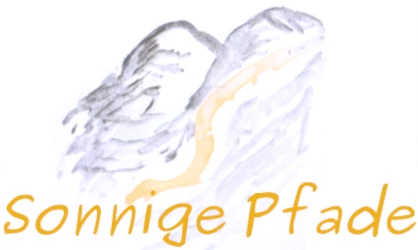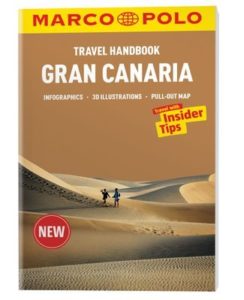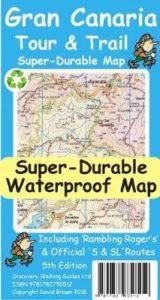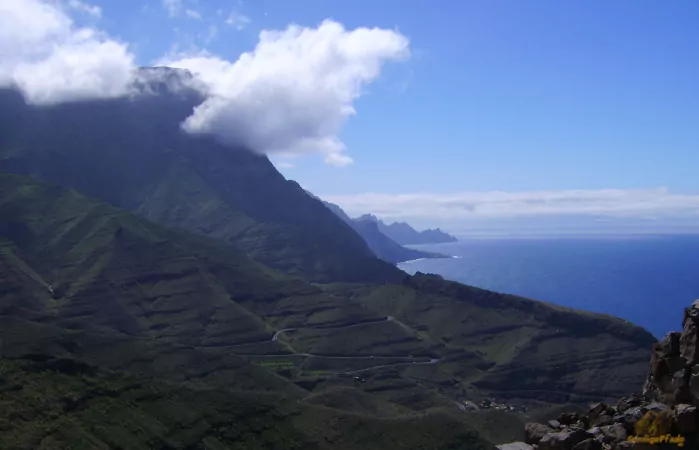
As the name already reveals, Gran Canaria is one of the Canarian Islands. It is the third biggest one beside Tenerife and Lanzarote. Tenerife and Gran Canaria are practically in sight next to each other in the Atlantic Ocean, Gran Canaria more to the east and therewith closer to the African mainland (210km). The archipelago of the Canarian Islands is located in front of it. Politically, the Canary Islands belong to Spain and are therefore EU territory.
Like all Canary Islands, Gran Canaria is a popular holiday island and is visited by bathers from all over Europe. But the island has more to offer – and that is what this article is about.
Gran Canaria north – Table of content
- High mountains, green valleys… Gran Canaria – island with diversity
- The island capital of Gran Canaria – Las Palmas
- Explorations in the north west of Gran Canaria
- Gran Canarias north – a small conclusion
High mountains, green valleys… Gran Canaria is an island with diversity
While most of the bathers are picked up right from the airport located at the south-east to Maspalomas and this southern region of Gran Canaria, where one hotel follows the other, I invite to explore the northern part of the island. As the northern part of the island is formed by a diversified mountain area with a lot of fresh vegetation – and there, it is worthwhile to simply go and explore these landscapes.
Volcanic island with new settlers
In the coastal regions you will probably discover some remote small beaches, which are hardly visited except by the locals and make the travel experience perfect. Otherwise, hiking trails invite you to explore the island. Since Gran Canaria, like all Canary Islands, is of volcanic origin and the volcanoes were active (geologically) relatively short time ago (about 2000 years ago), you will encounter bare rocks or lava fields between the vegetation-rich green zones every now and then, which have just been conquered by pioneer plants. In between, lizards scurry around and insects hum to visit the occasional flowers of the new settlers.

While some rocky plateaus heat up in the sun, the forest areas are fresher and more humid, partly it still drips in the morning from the trees and bushes and here and there springs arise. A pleasant contrast. The humidity comes from the thick clowds that rise over the Atlantic Ocean, are carried by the north-east trade wind and are practically stuck in the mountains of the island.
Water from clouds and fog
Especially in the morning, at higher altitudes, you can sometimes literally watch clouds getting caught in the mountains, tearing into shreds, climbing up from mountain valleys, leaving part of their wet cargo behind and being driven by the wind around the crests and over the ridges. The trees and vegetation of the island ensure that many drops of the clouds are deposited on the leaves and thus collect fresh water. Without the high mountain ranges and without the vegetation that „combs“ the water from the clouds, Gran Canaria would probably be a dry rocky island. The south of Gran Canaria is clearly drier in total. This dry heat is intensified by winds from the Sahara (Calima), which can bring sand and cause considerable temperature increases.
The island capital of Gran Canaria – Las Palmas
In the north-east of Gran Canaria lies the island capital Las Palmas – economic and cultural centre of the island and with approximately 380.000 inhabitants the biggest city of the Canarian Islands at all. The port is the most important economic link to the Spanish „motherland“ and an important economic factor for the whole island.
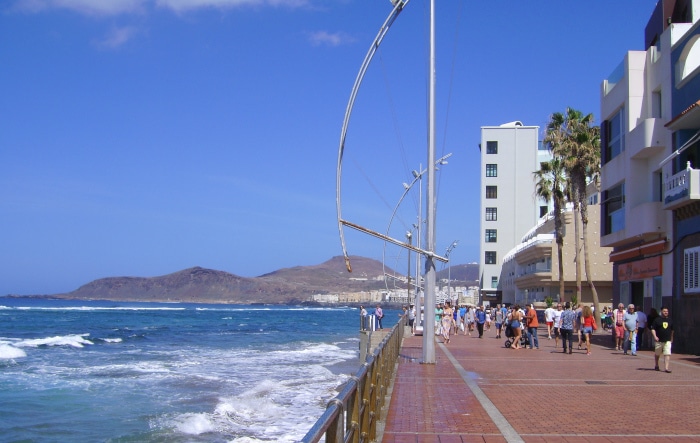
The city is well worth seeing and can offer you interesting entertainment for several days. Already the location makes the charm of Las Palmas: The historical centre of the city has grown on the north-eastern edge of Gran Canaria. But then the settlement expanded to the north over a headland, stretching far into the Atlantic Ocean.
Stroll at the Playa de las Canteras
So a part of Las Palmas lies on a hook in the sea. While at the eastern side there are mainly harbour facilities, the western shore strip in the city district Santa Catalina forms a wide city beach „Playa de las Canteras“ towards a bay. Thus, if there are not strong north-western winds blowing into this bay, you can lie on the beach in the middle of the city and enjoy the Canarian sun. Many of the inhabitants also use this possibility extensively. If bathing is not possible due to the winds, there is at least a refreshing walk on the kilometre long boardwalk that sometimes can be combined with a small shower from the spray that blows in.
Of course, behind the beach and the boardwalk there are the hotels, restaurants and other facilities as it is usual in holiday regions at the beach strip. The nice thing is that in Las Palmas, this strip is followed by normal city life with all its diversity and not by an artificial tourist landscape as it is the case in exclusive bathing resorts. Moreover, not only tourists but also many locals spend their free time at the beach, so that one hardly has the feeling of being in a tourist ghetto. If you walk down the beach to its southwestern end, you come to the modern concert hall „Auditorio Alfredo Kraus“ – a tenor born in Las Palmas.
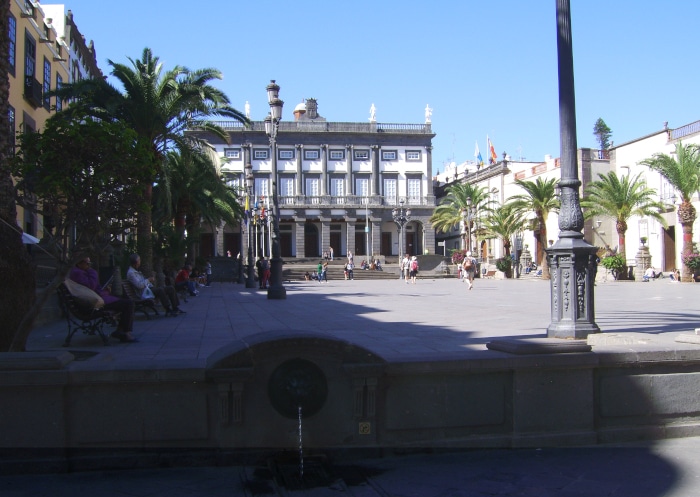
Otherwise, the city with its long history also has a number of historical and architecturally interesting buildings, museums, theatres and cultural institutions.
Old town quarter with bishop’s seat
t the very south, in the oldtown „Vegueta„, there is the cathedral St. Ana of the year 1497 that is the seat of the canarian bishop. Right next to it you will find the Diocesan Museum with a religious art collection and a very beautiful courtyard. The cathedral is also accessible through the museum. Opposite the cathedral, in the Plaza de St.Ana, you will find the classicistic town hall from 1853.
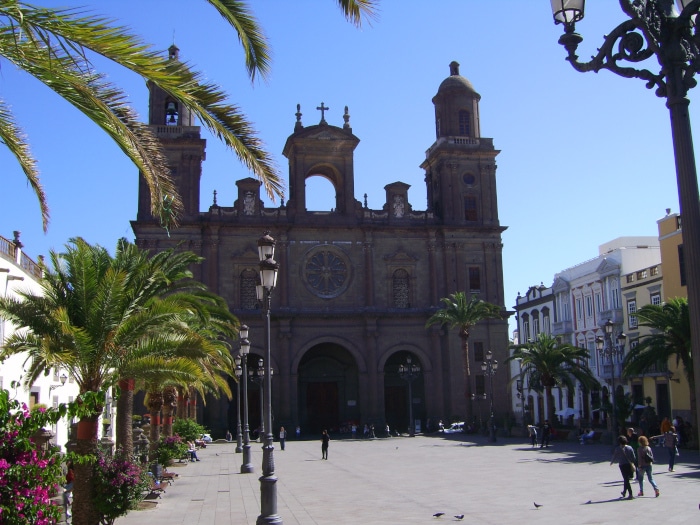


East of the cathedral, the narrow alleyways open up to a small plaza with the striking, richly decorated building „Casa de Colon“, which houses a museum for Columbus (= Spanish Colon). Altogether, the alleyways of this quarter are very characteristic.

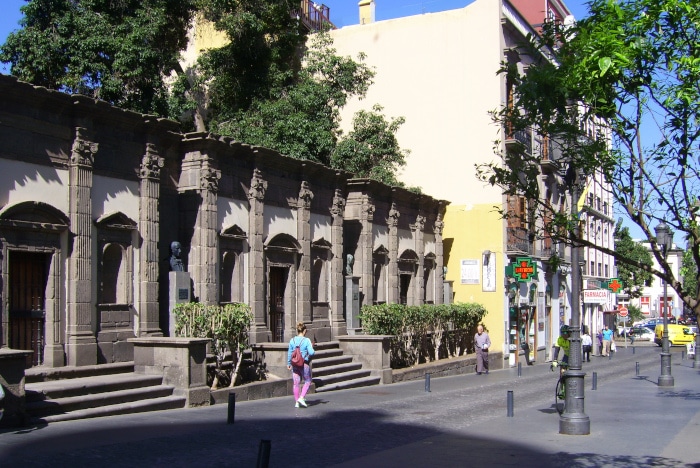
Pedestrians – Paths in the Art Nouveau Quarter
Separated by the main street Carretera del Centro, at the north, there is the district Triana that offers many pedestrian streets and shopping possibilities. Also some stylish restaurants and smaller snack shops are located in this area, so that it is easy to stroll around. At the eastern edge of this pedestrian area is the Plaza de Cairasco with a small monument to it and the literature cabinet and a little further the Plaza de San Francisco with a Columbus monument and the church of the holy Francis. All these areas are very nice to look at from the complex and the arquitecture of the buildings.
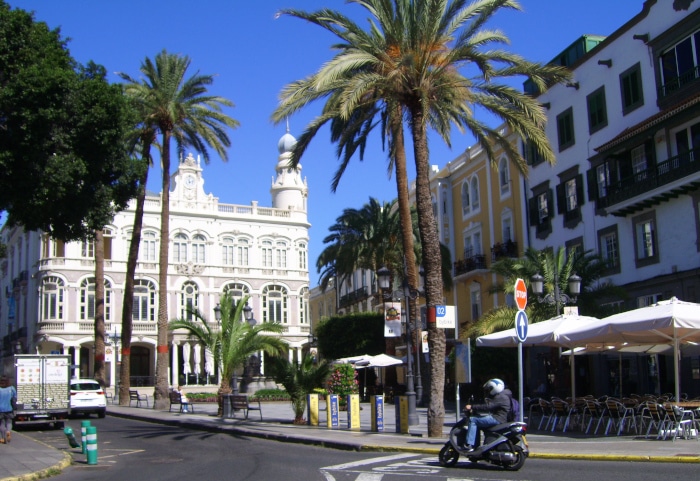

The pedestrian area with the most important street, Calle Mayor de Triana, in which a number of houses have Spanish Art Nouveau façades from around 1900, is closed off further north by the small park of San Telmo and the little seafaring church of the same name. Due to the many shady trees, this is a popular place to stay when it gets too warm due to the heat of the sun. In the east of the park towards the shore road is the underground bus station Estación San Telmo, one of the two big bus stops in Las Palmas. From here, many buses run across the island, but also to the airport.
Big events in Las Palmas de Gran Canaria are mainly the Carnival, which takes place annually at the end of January/ in February. An international film festival Festival Internacional de Cine Las Palmas de Gran Canaria uses the facilities of the Auditorio Alfredo Kraus for its annual event. And in November Las Palmas is home to the World of Music, Art and Dance Festival.
Explorations in the northwest of Gran Canaria
From the bus station San Telmo I drive to Agaete in the northwest of the island. This is a small quiet town on the mountainside with some nice cafes, a typical church, pretty houses in narrow alleys and a good starting point for walks into the interior of the island. The Puerto de las Nieves, a small fishing and ferry port, is also not far away. There is a stone beach and meanwhile the important ferry landing stage for the Fred Olsen ferries between Gran Canaria and Tenerife. The big neighbour island is practically in sight.
The bus trip runs over the motorway north: Autovia del Norte (GC-2) mostly alongside the coast. Partly, it goes through tunnels or over big bridges that cut off the mountain valleys „Barrancos“ coming from the interior of the island. At Gáldar in the north-west, the road leaves the coastline and runs south of the „Alto de los Mojones“ (502m), that here pushes the road away from the north-western tip of the island.
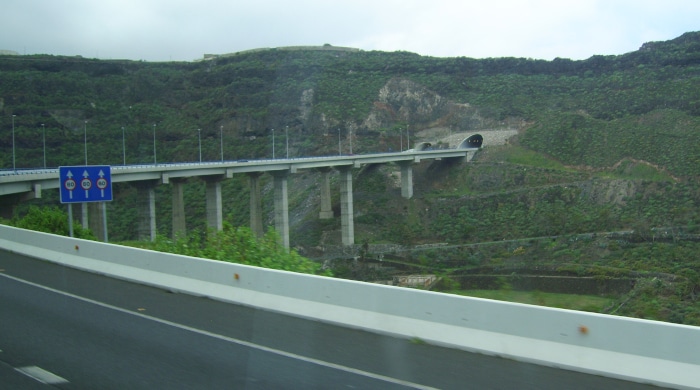

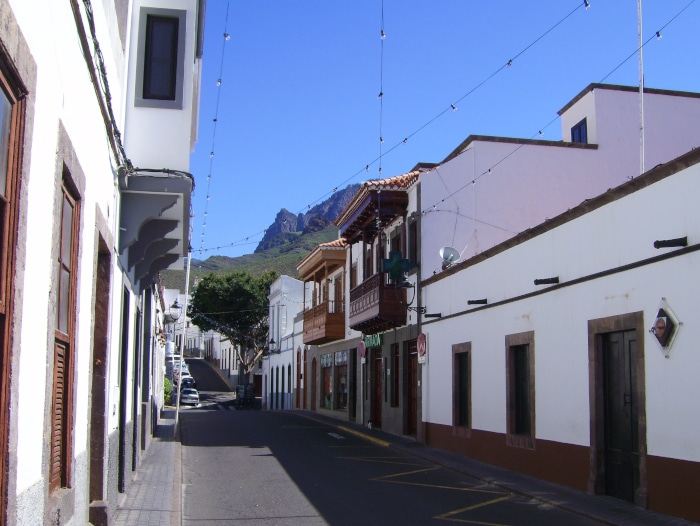
Agaete and Puerto de las Nieves
Between Agaete and Puerto de las Nieves you can also walk quite well – a nice exploratory walk down to the harbour. There, the „Dedo de Dios“, the finger of God, rises into the air – a rock needle from which a big part was still torn off during a storm in November 2005. Bring your swimsuit with you, because even though it is a rocky beach that feels a little hard on your feet, you will certainly enjoy the bathing opportunity. On this small beach most of the guests are locals. Above on the „beach promenade“ there are several fish restaurants that process the fresh catch into gourmet fillets. As I only eat fish in a few exceptional cases, I rather ordered a Canarian cheese au gratin that was stylishly served on a stone plate. With a good red wine – that’s the way to live!


Worth seeing is also the flower garden „Huerta de las Flores“ with the café, where you can enjoy your break in the scent of the blossoms.
Further small beaches as the Playa de Guayedra (specially for nude bathers) or the Playa de Faneroque are at the south of Puerto de las Nieves, most of the times accessible over steep paths out of the mountains. All are stone beaches. The calmness in this area is currently probably a little disturbed by the construction of the extension of the GC-2 highway. Above the last mentioned beach there is the Roque Faneque, with 1027m the highest peak of the north-western coastal mountain range.
Hiking in the valley of Agaete
Just behind Agaete the road leads into the valley of Agaete (Valle de Agaete), but not downhill but uphill. The mountains on the left and right rise even faster. Beside the also not very wide road, several mountain paths lead into the valley and the adjacent mountains – and there it becomes really nice to hike. Especially in the winter and early spring months, when it is still cold and dark in Central Europe, it is fun to experience spring or early summer there. And the morning fog clouds from the Atlantic provide freshness in the landscape. Possible hikes are, for example, from Agaete to San Pedro, also as a circular hike in the valley of Agaete. Or from San Pedro further over El Hornillo to the Lugarejos reservoir.

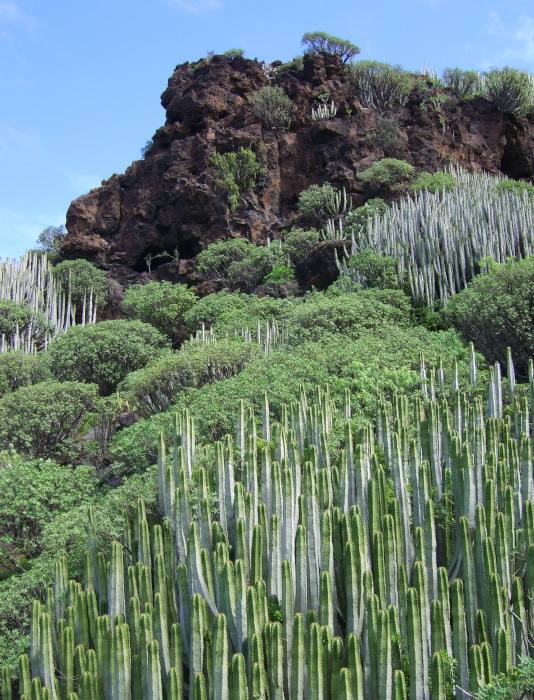

Tumuli in a lava field – Maipes Archaeological Park near Agaete
The small archaeological park Maipes is also interesting near Agaete. (Maipes is borrowed from a Canarian word and means as much as bad, infertile land) Here, on a lava field, early burial mounds of the 8th to 11th century were discovered. The people were buried in artificial chambers and high stone pedestals with a height of up to 2m were piled up on top of them. On the grave mounds, coloured stones of different origin were probably still deposited as „keystone“.
The area is well developed, a small exhibition gives an overview and besides the archaeological expertise, the geological situation as well as the flora and fauna of the surroundings are pointed out. The site is even largely wheelchair accessible: Steel plates have been laid and welded to the lava rock as a path. There are also some stairs, but all important views can also be reached on an inclined plane via this path.
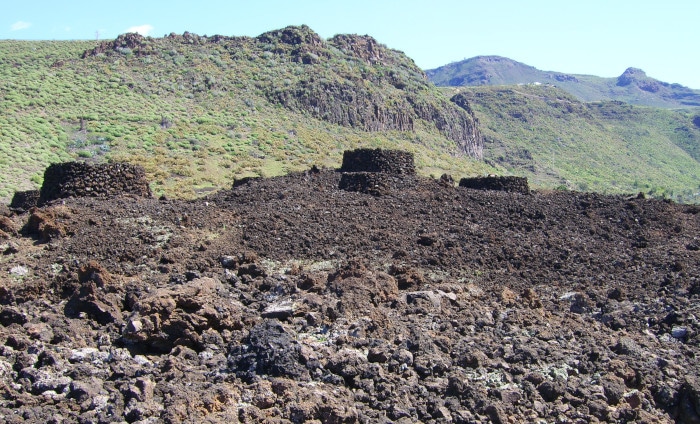

Gran Canaria’s north – a small conclusion
It is precisely these discoveries that lie outside the paths of package tourists. It is worthwhile to discover the island of Gran Canaria in an individual way and thereby rather look for places that are not so much in the focus of the mass tourism. Then also a holiday island that many people think they know can offer some really exciting new experiences. Because Gran Canaria is not only a bathing island but also good for mountain walks.
[Contains *advertising]
Travel tips for Gran Canaria
Arrival
Since it is an island, land transport is excluded. Therefore, there are two possibilities to get to Gran Canaria:
The sea way to Gran Canaria by ship
From Spain, several ferries leave at least in summer in direction to the Canary Islands. In winter the service may be „thinned out“, but at least once a week there are ferry connections during this time as well.
There are two ports of departure in mainland Spain: Huelva and Cadiz. However, from Cadiz there is only one departure a week to Gran Canaria with a journey time of 46 hours, 30 minutes. At the moment the ferry company is Trasmediterranea.
Huelva is served twice a week with 31 hours driving time by Fred Olsen, by FRS once a week with about 33 1/2 hours driving time.
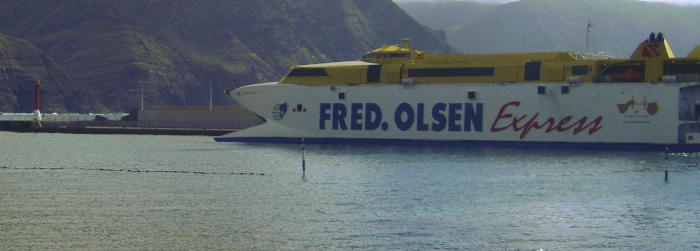
With the ferry as pedestrian, cyclist, motorcyclist or car driver
Depending on the ferry company and availability, it is possible to take bicycles, motorbikes or cars with you, to check in as a pedestrian only, to book a cabin with different standards or as the simplest option to choose only „Pullman seats“ (i.e. simple seats similar to those on the bus). Of course all this is also a question of money. As a simple passenger the price starts from about 100€ (result of my short check as a simple foot passenger with Fred Olsen, July 2020). Bicycle transport will not be that expensive either, but from the motorbike on, the whole thing will be a matter that needs to be calculated. Because a rental car* is usually cheaper to have. Especially if you think carefully about when you need a vehicle to be independent and when you are only going to the beach or the city anyway.
However, such a ferry crossing can be like a small cruise – only without a lot of fun on board.
Island-hopping and little crusade
If you are already on Tenerife, you can take the ferry from Santa Cruz directly to Gran Canaria. Also from all other Canary Islands – Islands ferries run at least once a week to Gran Canaria. Check and book online your ferry between Canary Islands at omio*
Yes – you can also come to Gran Canaria by cruise ship! The Canary Islands – roundtrip ferries regularly call at Las Palmas, where there is often an exchange of many holidaymakers. This means that one possibility is to extend your stay on the island of Gran Canaria before or after a cruise and spend a few relaxing days.
By plane to Gran Canaria

The airport of Gran Canaria (IATA code LPA) is located about 18km south of the capital Las Palmas on the east coast. It is well integrated into the European flight network and is served directly by many airports on the continent. You can find and book your flight online at the omio booking portal*.
The majority of flights are holiday flights. Therefore it makes sense to look for cheap remaining seats from travel agencies*. They may be a little more expensive than the low-cost airlines such as easyjet*, which also fly to Gran Canaria, but they usually have a little more legroom and comfort. With a flight time of about 5 hours e.g. from Leipzig, this is not a bad idea, as it is a little more comfortable to travel. For the long time it is good to take something to read with you.
Regular air traffic exists also to all other Canary Islands, usually several times a day.
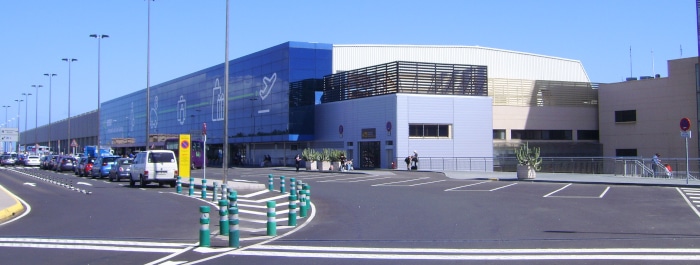
The time zone of Gran Canaria
In Gran Canaria, Western European Time zone is the norm. Compared to Central European Time zone (CET), this means a shift of minus one hour (CET -1). So, if it is 12:00 noon in Central Europe, then on the Canary Islands it is only later in the morning, 11:00. Unless politicians turn the clock and declare so-called daylight saving time, the Canary Islands time corresponds to world time (UTC) on the Greenwich 0 meridian.
The Gran Canaria weather and the best time to travel
It is beautiful all year round in Gran Canaria! Actually almost always spring weather. The proximity to the equator provides warmth and sunshine, the Atlantic Ocean provides freshness… Only in the south it can get very hot when the hot winds blow from the Sahara. In summer it gets warmer, but also not as great as in the continental mainland climate – the Canarian current cools the region down again and again.
You have to expect some rain, especially in the winter months from November to February. But it usually doesn’t last long – most of the rainfall on Gran Canaria, which keeps the island green and fresh, comes as fog from the sea. This is the reason why it is clearly drier in the interior of the island and the vegetation is much poorer. Don’t forget the sunglasses!*
Accommodation in Gran Canaria North
The capital of Gran Canaria, Las Palmas offers a lot of hotels in different parts of the city. The highest density of accommodations is of course at Playa de las Canteras in the district of Santa Catalina. This is quite a distance from the historical center. So you have to decide if you prefer to have the beach in front of your nose or if you want to stroll around in the old town, visit museums and enjoy the Canarian – Spanish atmosphere. There are city buses and for a rental bike or an eScooter there are also cycle paths,. But when I am in a city, it is always nicer to have exhibitions and old buildings around me and to enjoy a glass of vino tinto in a street bar in the evening.
budget – Accomodation at Gran Canaria
budget – Accommodation in hostels* is available on Gran Canaria (almost) only in Las Palmas. There, however, the choice is quite good and the hostel operators are often very eager to spoil their guests with additional offers such as evening cooking for all or guided tours. The prices for a dorm bed start at 10€ and go up to about 20€.
Las Palmas, Santa Catalina ( at the Playa de las Canteras)
A good choice for music lovers is Las Canteras 7urbe*, an apartment with bedroom, bathroom and shower. Because it is only 18 minutes walk to the Auditorio Alfredo Kraus. The Playa de las Canteras is about 400m away.
Living Las Canteras – Beachfront Roof Top Terrace* is an apartment close to the beach. It has two bedrooms and a well equipped kitchen. From the spacious terrace you have a view over the beach and the Atlantic – bay.

In Canteras vista Playa* you can get an apartment for a larger family if required. The beach is very close by. Kitchen, washing machine and bathroom are available in the holiday apartment. For self-catering there is a supermarket and also restaurants are not far away, including a Cuban „Esquinita Cubana“.
The Villa Marina, Sol y Sal* is located directly on the beach and has a terrace with infinity pool. For up to 4 guests there are two bedrooms and a kitchen available.
Las Palmas, Triana and Vegueta (old town)
The stay Las Palmas* offers several apartments in a good location to reach the old town attractions of Triana and Vegueta in a short distance. The kitchen is equipped with toaster, microwave and refrigerator. Good internet is available in all holiday apartments. Casa de Colon and Cathedral are about 100m away, Calle Triana 200m.
Top accommodations in Las Palmas
Royal Hideaway Hotel *****
The Royal Hideaway Hotel in Santa Catalina* is a 5-star hotel just a few meters from the marina. Friendly air-conditioned rooms, almost all with balcony or terrace, offer great comfort for the guests. An outdoor pool and wellness area with whirpool and Turkish baths are available in the hotel. Three restaurants provide gourmet delicacies, two bars offer drinks for relaxed evenings.
Bull Reina Isabel ****
The 4-star Bull Reina Isabel Hotel* is located only 300m away from Playa de las Canteras. With a rooftop pool, free wellness center and fitness room, the demands of active guests are met. Free towels, sunbeds and parasols are available for the beach. The air-conditioned rooms have a balcony, the hotel has a roof terrace with a view of the Atlantic Ocean. A bar awaits the guests at the roof pool as well as at the beach.
Old Town – Hotel Suites 1478 *****
For those interested in history and art lovers, the small old town – Hotel Suites 1478* is the best 5-star address in Las Palmas. Located in the Vegueta district, the roof terrace offers a view of the Santa Ana Cathedral. The Casa de Colon is only 200m away from the holiday apartment. Beautiful, air-conditioned rooms with bathrooms arouse sympathies with tasteful furniture. A good breakfast is provided by the in-house restaurant.
Boutique Hotel Cordial La Peregrina ****
In the heart of the old town’s Triana district, yet with some luxury, is the Boutique Hotel Cordial La Peregrina* in Las Palmas de Gran Canaria. On a street parallel to Calle Triana boulevard, this hotel is close to San Telmo park and bus station, as well as to the Vegueta neighborhood with Santa Ana Cathedral and Casa de Colon. Single and double rooms in the hotel are air-conditioned. A rooftop terrace with outdoor pool provides year-round relaxation in the fresh air. The hotel offers a daily breakfast buffet.
Accommodation in and near Agaete on the north-west coast of Gran Canaria
Beach lovers will find their accommodation in Las Nieves Blue* very close to the beaches of Agaete. The small district Puerto de las Nieves with its harbor and coast is the gateway to the Atlantic Ocean. The fast ferries to Tenerife also start here. The center of Agaete is about 1km away on the hill. Las Nieves Blue offers accommodation for up to 8 guests in four bedrooms. A private pool is part of the complex. If the sun of Gran Canaria is not enough for you, you can tan in the solarium.
Those who prefer to use a hotel will find spacious rooms in the Hotel Puerto de las Nieves*. The rooms are furnished with warm wooden furniture in the Kaptain style, in keeping with the maritime location not far from the harbor and (stone) beach. If the weather does not permit a swim in the Atlantic, there is an alternative in the pool in the basement of the hotel, including Jacuzzi. Also fitness and various wellness – offers can be used. Other activities such as guided bike tours, hiking or diving can be arranged. The center of Agaete is about 1km from the accommodation. The public bus to the island capital Las Palmas de Gran Canaria stops practically in front of the house.
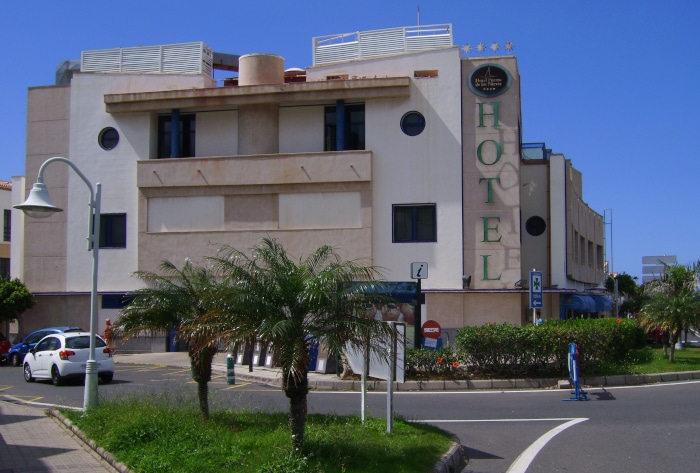
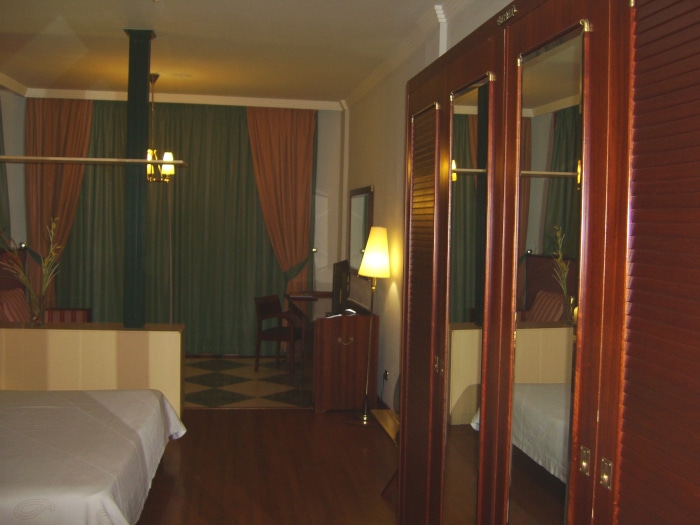
Holiday Apartments and houses further out in the mountains near Agaete
A vacation property Casa Rural la Asomadita* invites guests to a quiet valley location about 3km outside Agaete. Four bedrooms, each with 2 beds, are available for guests. The beaches are a bit further away, but a spacious outdoor pool at the vacation home attracts for swimming. Guests are especially enthusiastic about the view into the valley of Agaete.
Apartment Makondo* is a good choice for hiking enthusiasts. It is also located just under 3km from Agaete. One bedroom with a double bed is available, furthermore, by means of a sofa bed in the living room, the overnight capacity of the vacation apartment can be extended to 4 guests. The terrace offers a fantastic sea view. The kitchen with stove and oven makes independent from restaurants. However, there is at least one restaurant and one café nearby. Directly from the apartment, hikes in the valley of Agaete and the surrounding mountains in the northeast of Gran Canaria can be started quickly.
With Mirador de Valle* you can look forward to a quiet vacation home with views of the mountains of Gran Canaria. The double bed in the bedroom and the sofa bed in the living room together accommodate 3 adults in this charming accommodation. A fully equipped kitchen is available in this vacation home. The large terrace extends the space to a pleasant retreat with views of the sea and mountains.
Money at Gran Canaria
Like everyqhere in Spain the €uro is the common currency at Gran Canaria. You can get money everywhere at the ATM. So far there were – not like at Mallorca – no extra machine fees. Or you can pay with your credit card in many places. Beware of pickpockets and take a secure bag for money and values.
Gran Canaria Travel guide and walking map
With the Marco Polo travel guide for Gran Canaria* you can discover the island the better. Because this little book contains a lot of detailed information about landscape, culture, special places, tasty food and much more. Practical are interspersed „low budget“ tips, which do not burden the travel budget. A small general map to take out makes it easier for you to find your way around.
The Gran Canaria Tour & Trail hiking map* helps you to find good trails for your island experience. A 50k scale reveals many details on your hike. The map material is weatherproof, so that even a rain shower can not harm the map. A digital version for Garmin – users complements the conventional paper map in the free download. So the map is a good companion for Gran Canaria mountain walks.
Share the post!
Did you like „In the North of Gran Canaria“? Then please share the link to the post on your social-media channels! Maybe you will quickly find interested travel companions 🙂 A positive response on the net helps to support good posts and to separate the wheat from the chaff…
As a little summary here ist a Gran Canaria FAQ:
The island of Gran Canaria is located in the North Atlantic Ocean about 210km off the West African coast (Morocco). It belongs to the group of Canary Islands.
Although the island of Gran Canaria is geographically rather assigned to Africa, the Canary Islands belong to the national territory of Spain and is therefore part of the European Union (EU). Spain belongs to the „Schengen – States“, which have agreed on a common internal space without controlled internal borders. Therefore, when traveling to Gran Canaria from another Schengen state, there are no border controls.
Gran Canaria and all the Canary Islands are in the Western European Time zone. Apart from shifts due to daylight saving time games of some countries, the Western European Time is equal to the time on the 0 meridian of Greenwich (Greenwich Meridian Time GMT). For visitors from the Central European Time (CET) time zone, this means a shift of -1 hour.
The Canary Island of Gran Canaria is characterized by the climatic conditions of the Atlantic Ocean and the nearby continent of Africa. Thus, spring to summer weather can be expected all year round. In addition to beautiful coastal regions with large beaches, especially in the south, Gran Canaria has large mountain ranges, which with volcanic rock and a variety of exotic green plants form a strong contrast to the blue sea. Small and larger cities, especially the island’s capital Las Palmas, offer architecturally and culturally charming attractions with a long history. These beauties and sights of Gan Canaria are very easy to explore individually because of the excellent tourist infrastructure.
Well known are the old town Vegueta and the city beach Playa de las Canteras in the island capital Las Palmas. Many bathers also know the sand dunes at Maspalomas in the south of Gran Canaria. Nearby is the „Palmitos Park“, a palm and animal park that is popular with many visitors to the island. Botanically interesting are the laurel forests in the north and the cactus-like Canary Island spurge, which can be found mainly in the south of Gran Canaria. Also an impressive destination on Gran Canaria are the approximately 290 caves Cenobio de Valeron, which were dug into the tuff by the indigenous people as granaries. A lot of sights for your individual Gran canaria Tour!
Bathers travel mainly to the south of Gran Canaria around Maspalomas and Playa de Ingles. Because there you will find wide large sandy beaches, many hotels and other accommodations, rather dry, sunny regions and everything that bathers expect. Those who are looking for less tourist hustle and bustle as well as a varied landscape with mountains, forests, rugged rocky coasts and smaller beaches, some of which are formed by coarse pebbles, prefer to travel to the north of Gran Canaria. There you will find more places that offer authentic Canarian life with varied culture and artistic and historical exhibitions.
Reference to advertising
Some of the links in this post are marked with *. If you click on them and then shop in the linked shop, the sonnige pfade blog will receive a small commission for maintaining this blog. Nothing will be more expensive for you, because the commission is already included in the price.
